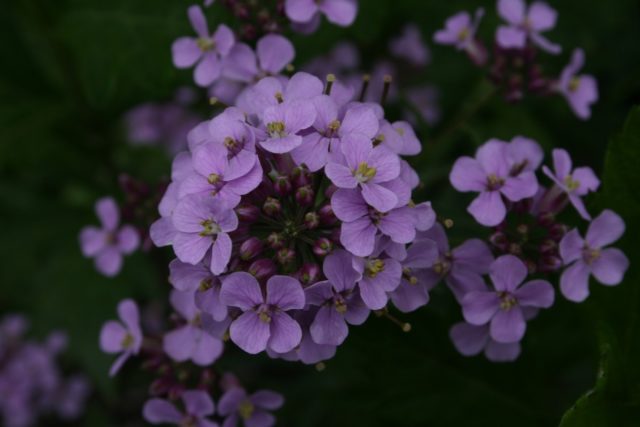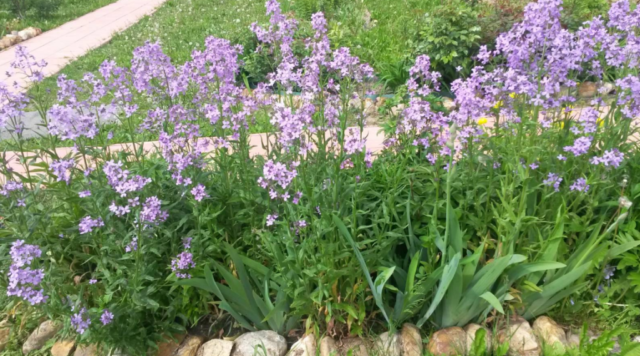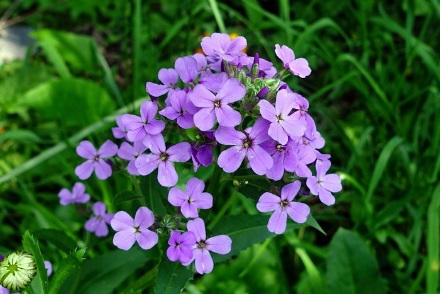Content
Night violet flower is a perennial herb from the Cabbage family. Most species are intended for indoor growing. Few ornamental varieties are cultivated in the open field. The plant is modest in size, but despite this, it is often used in landscape design to decorate plots.
What does a night violet look like?
Mattiola flower (Matthiola) is a low-growing plant, up to 50 cm high. Night violet bushes have branched herbaceous shoots. The plant is erect with straight stems of dark green color. Their lower part is covered with numerous basal leaves. They are long, pointed, light green in color. In the upper part of the night violet, under the peduncles, the leaves are shorter and have rounded ends.
Mattiola has simple four-petalled flowers. Their diameter is up to 4 cm. They form small brushes. The color ranges from purple to pale pink.

Night violet bloom begins in the evening
The plant usually blooms in mid-June. In some regions, the flowering period is shifted. In the south, it can start at the end of May.
Other names
Perennial night violets are known by many names. Such a plant is often called a nocturnal plant. This is due to the fact that the flowers bloom after sunset and begin to exude a pleasant aroma.
Matthiola is also often called Levkoy. This is the collective name for the night violet flower and all representatives of this genus.
Where and how it grows
The plant was brought from the countries of Southern Europe. The night violet is common in the Mediterranean and nearby regions. It is known that the nocturnal plant was used for decorative purposes even in ancient Greece.
Night violet is not demanding on growing conditions. In natural places, mattiola slopes towards self-seeding. After the summer bloom, seeds are formed. They spill out onto the soil, then germinate and take root.
Varieties and varieties
There are 2 known variants of the night violet. The first is Hesperis, or nocturnal. It is an erect herbaceous shrub up to a height of 50-60 cm. When peduncles appear, it can reach 120 cm. Stems are narrow, with long green pointed leaves.
The main varieties of hesperis:
- Evening party of the matron (Hesperis matronalis).
- Siberian (Hesperis sibirica).
- Persian (Hesperis persica).
- White evening party (Hesperis alba).
The second variety of night violets is Pink Mattiola. It is also represented by numerous varieties, representatives of which differ in external characteristics.
Application in landscape design
For decorative purposes, pink, purple and white night violets are used. Varieties of other colors are rarely planted outdoors. Many ornamental species are annuals or biennials.
Night violets are planted in groups. Usually they are placed in large areas at a distance from each other. Low-growing shrubs are planted next to the hesperis: ferns, hosts, badan.

Mattiola is well suited for compact planting in flower beds
Night violet is suitable for group planting with other ornamental plants.They are used to create rock gardens, mixborders, decorate borders and artificial reservoirs.
Vechornitsa flowers can be planted in flowerpots and placed on the veranda, balcony, in the loggia, or decorate the facade of the house with them. Designers recommend planting night violets near places of evening recreation.
Breeding features
Night violets produce a large amount of seeds. If the peduncles are not cut, then they fall into open ground, where they germinate and begin to bloom the next year. Collect seeds of night violets for subsequent planting should be in early September.
If matthiola is not yet on the site, it can be grown in seedlings. Seeds of a suitable variety are obtained from a garden store.
Reproduction by dividing or grafting matthiola is not used. Any damage to the bush can lead to its death.
Growing seedlings
This method is not always advisable. Seeds can be planted in open ground without preliminary preparation of seedlings. They are most likely to sprout and grow in a short amount of time.
For regions with unfavorable climatic conditions, it is recommended to grow the matron's hesperis from seeds by seedling. Sowing is carried out at the end of March or in April.
For planting use:
- seedling cassettes;
- food grade plastic containers;
- peat tablets;
- small pots;
- plastic glasses.
Fresh garden soil mixed with river sand and compost should be poured into the container. The soil is well watered to keep it moist.
Sowing method:
- Soak the seeds in potassium permanganate for 20 minutes.
- Fill the seedling container with moist soil.
- Loosening.
- Make indentations 0.5-1 cm.
- Place the seeds of the night violet inside.
- Cover the container with plastic wrap.
Seedlings should be kept indoors at a temperature of 18 degrees. Seedlings need regular moistening from a spray bottle. A night violet pick is not required.

Sprouts with 3-4 true leaves are transplanted to a permanent place
Planting and care in the open field
The technology of growing hesperis from seeds is not difficult even for gardeners who have not previously had experience with such plants. Night violets grow well in almost any conditions, they are not sensitive to negative environmental factors. When planting, it is enough to take into account a few simple rules.
Timing
Young violets obtained by seedlings should be transplanted into the soil in early or mid-May. Then mattiola will have time to take root in a new place and will most likely bloom in the first year.
Sowing seeds in open ground can be carried out during the period of persistent warming. The constant temperature of the soil should not be lower than 10 degrees. Seeds are usually planted in April, when the risk of night frosts has passed.
Site selection and soil preparation
Night violets are not picky. They can be planted in sunlit or shaded areas. It is not advised to grow noctresses in the shade, since a lack of light will negatively affect its condition.
Seedling planting method:
You can not plant flowers of mattiola night violets in the lowlands. When atmospheric precipitation occurs, liquid will accumulate there, which can provoke rotting of the roots.
The sowing site must be protected from the wind. Otherwise, peduncles should be removed from the bushes annually until the seeds form. Otherwise, the flower will multiply by self-seeding.
Sowing seeds directly into the ground
This growing method is very simple. It is enough to procure or purchase the required amount of seeds.
How to plant a night violet in the ground:
- Dig a layer of soil to a depth of 10-12 cm.
- Apply compost, dry manure or peat.
- Loosen so that there are no large clods of earth on the surface.
- Make indentations of 1 cm at a distance of 15-20 cm from each other.
- Place the seeds in the holes.
- Sprinkle with loose soil.
- Drizzle with water.
When planting, you need to ensure that the soil allows air to pass through well. Otherwise, the seeds may not germinate.
Transplanting seedlings
The selection and preparation of the site is carried out in the same way. Seedlings must be transplanted in a timely manner, otherwise it takes root deeply and is easy to damage.
How to transplant seedlings:
- Loosen and fertilize the soil in the area.
- Make landing pits or furrows.
- Remove the seedling plant with a knife, small spatula or wooden stick.
- Place it in the planting hole.
- Cover the roots with soil and compact slightly for stability.
- Drizzle with water.
It is believed that night violets grown by the seedling method do not tolerate transplanting well. Therefore, the procedure should be carried out with care so as not to damage the flower.
Watering and feeding schedule
Matthiola needs a lot of liquid after planting in the ground. Watering is carried out 1 time in 2-3 days. Subsequently, it is reduced to one per week. In the summer season, watering is carried out as the soil dries out.

Night violets bloom well without feeding
Fertilizers can only be applied to increase the flowering time. To do this, during the budding period, a complex mineral composition with potassium and nitrogen is introduced. Wood ash acts as an auxiliary feeding. It is brought in once a month.
To keep the soil moist in summer, it is mulched with bark and compost. In this case, you need to ensure that there is no stagnation of water in the roots.
Weeding and loosening
The area where the night violet grows is regularly cleared of weeds. Climbing, fast-growing plants are especially dangerous. They can twine around thin stems, after which it is very difficult to release them.
As the soil compresses around the bushes, loosening is carried out. The optimum cultivation depth is 8-10 cm. This improves air flow to the roots and prevents liquid stagnation.
Diseases and pests
As you can see in the photo, improper planting and care of night violet flowers can cause fungal infections. This is usually due to abundant watering or excessive soil density.

The main symptom of the disease is premature wilting.
Some pathologies are accompanied by the appearance of growths, spots on the sheets and death. Sick specimens are recommended to be transplanted, after removing the affected leaves and stems. The roots are soaked in potassium permanganate before planting.
Due to the close location of plants, powdery mildew may develop. To combat this disease, fungicidal agents are used.
It is advisable to treat the night violet with insecticides. Due to its strong smell, it can attract butterflies, which will lay eggs on the plant. Larvae and caterpillars can eat foliage, which will affect the appearance. Processing is carried out before flowering.
Conclusion
The night violet flower is grown with little or no effort. The plant thrives on poor soils, does not need frequent watering and feeding. At the same time, night violets are distinguished by long flowering. They bloom in the evening, which distinguishes it from many other ornamental plants.








